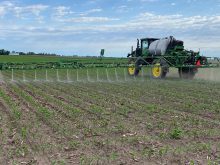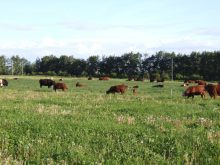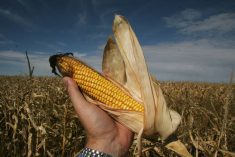Glacier FarmMedia – Intercropping can have significant benefits for extended grazing cattle on shoulder seasons, says Emma McGeough, associate professor in the department of animal sciences at the University of Manitoba.
She and her research team of graduate students have been working for the last number of years on the intercropping of corn for fall and winter grazing.
“Realistically, we think of inter-cropping as a practice of growing two or more forages or crops together in the same field,” she said at the Western Canada Soil Health and Grazing Conference in Edmonton late last year.
Read Also

First annual Ag in Motion Junior Cattle Show kicks off with a bang
Ag in Motion 2025 had its first annual junior cattle show on July 15. The show hosted more than 20…
She said there is growing interest in the use of intercropping. Deciding what additional species to grow and how to approach the intercrop will depend on what farmers want to achieve. It can be used for extended grazing in the fall or winter or to have a potentially high-yielding crop come spring.
“This is not news for anyone in the room, but overwintering is a very significant feed cost for producers,” she said
“Approximately two-thirds of costs associated with cow-calf production in Western Canada do arise from feed. We are seeing an increased reliance on lower costs for marginal or less productive lands to meet forage needs.”
McGeough moved to Winnipeg 10 years ago and noticed that weather patterns have changed a lot since then. Rain is now more unpredictable.
Extended grazing offers reduced feed costs compared to feeding in confinement. It also distributes nutrients from cattle to the soil and offers a flexibility of location, depending on fencing and watering.
Other benefits include lower labour and time requirements, improved animal health, environmental benefits and potential agronomic benefits.
For Prairie farmers looking to lower their feed bill, even in the depths of winter, corn grazing has become a popular option.
Corn can be a high yielding crop and produce a lot of feed per acre. It can also be an effective windbreak. However, corn is not cheap, and the crop by itself does not fill the nutrition needs of cattle.
“Corn is low on protein, but it is not short on energy,” said McGeough.
If corn has a protein level of seven or eight per cent, that’s not going to be good for growing cattle, or for cows later in gestation.
In pure corn grazing systems, supplementation with feed such as alfalfa are key in making the system work, as well as avoiding bloat. Producers are typically advised to make sure cattle are full before entering a new corn paddock to avoid gorging on cobs.
There is also the cold weather and its impact on metabolic requirements to consider. Extension staff with Manitoba Agriculture advise that feed intake can jump up to 30 per cent in prolonged cold, while faster digestive passage also means the amount of energy cattle get from a set amount of forage can be reduced.
It’s suggested that energy requirements jump by 10 per cent for every 10 degrees below 15 C.
Other forage crops might help round out the grazing, but the concept left many unanswered questions. Would the crops establish properly between the corn rows? Would there be enough to make a significant difference to supplementation needs?
McGeough talked about a study she worked on with multiple sites across the Prairies. Some of them were seeded early, but others were just bone dry.
“So we said, ‘OK, we have the seed. We got good rain and we ended up getting a pretty good crop out of it,’” she said.
It’s not necessary to give it up if the crop doesn’t work at the precise time the farmer planned, she added.
“Again, we will see different competitiveness depending on the crop and depending on the cleanliness of the field when we start. But that can be something that will mitigate the success of our potential intercropping. Whether it’s a small cereal or whether it’s a forage or legume, we do have to give them the best possible chance.”
McGeough and her team planted corn on two sites in Manitoba on a standard row spacing, about 30 inches apart. They interseeded that with a variety of crops, including Italian rye, red clover, hairy vetch and radish. The crops established, but they were tight.
The team then embarked on a Prairie-wide study. Researchers wanted to see if they could establish intercrops with grazing corn at multiple sites across the Prairies. Sites included multiple sites across all three Prairie provinces.
At the sites, they doubled the row spacing and started with 60-inch spacing. They also had a control on a 30-inch spacing. Corn was seeded in early to mid-May, and then the crop was interseeded. This was done in 2021, 2022 and 2023.
In their studies, the research team found that the corn was unharmed by any crop except radish. In terms of crude protein, crimson clover was the lowest from 10 to 13 per cent overall. Radish and hairy vetch had the highest crude protein. The intercrop offered higher protein potential than corn alone at all sites.
In terms of total digestible nutrients of the intercrops, crimson clover came in low, while radish came in at 20 to 30 per cent higher digestible nutrient. Knowing the true picture of your feed is why feed testing is so important, she said.
The nitrate concentration of some of the crops, the radish in particular, did exceed the threshold. That was partly dependent on the year and the site because drought stress causes nitrates to spike. This research proved that intercropping worked on a small plot.
McGeough said there are many things to consider when planning a corn intercrop, and only some are under a producer’s control. Rain is a very important factor.
“The complementarity and the competitiveness of the species that are in the mix, that is going to influence if you seed something and it’s just going to be choked out. Then it’s not a good use of your money,” McGeough said.
There are many agronomic choices to consider, such as seeding rate, seeding depth and dealing with seeds that are not the same size.
McGeough is frequently asked about weed control because of the sometimes limited herbicide options when more than one crop is in the mix. Her answer is that it’s important to think about strategies before the crop is seeded to really set it up for success.
Nitrate toxicity can be another problem, McGeough said.
“If we are heavy with nitrogen fertilizer, yes, we may see an increase in yield and protein concentration, but if that spikes our nitrates, that’s something we need to be considerate of.”
Fortunately, nitrate toxicity is not that common, but it is a consideration for mixes that include crops such as brassicas.
“It doesn’t mean that all brassicas are going to have high nitrates in all conditions. We do know they decrease over time as well,” she said.
She stressed the importance of feed tests and soil tests.
“If we’re thinking about nitrogen toxicity, if we’re at about 0.5 per cent, that’s generally considered our safe limit. If we go to 0.5 to one per cent again, we advise caution. And for over more than one per cent, we do have to be a bit worried about that,” she said.
Nitrogen toxicity is complex because starch in the diet can reduce the impact of high nitrate feed. Those high nitrates in feed can cause fatalities, asphyxiation or abortions. That’s why it’s doubly important to do soil tests.
Cattle management can also be key in limiting the risk, attendees heard.


















